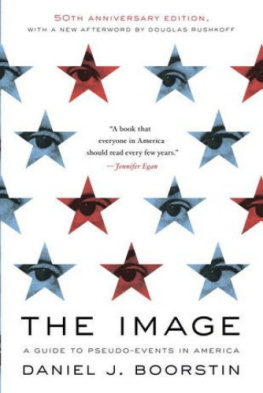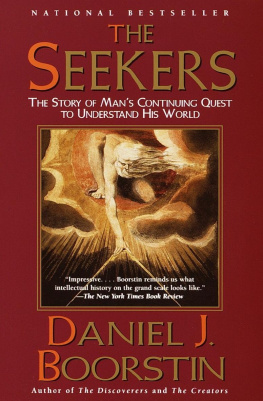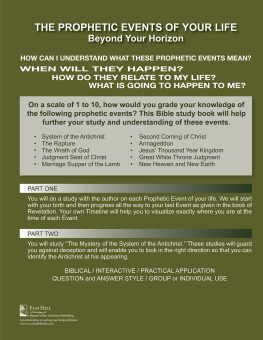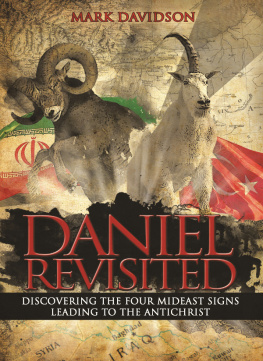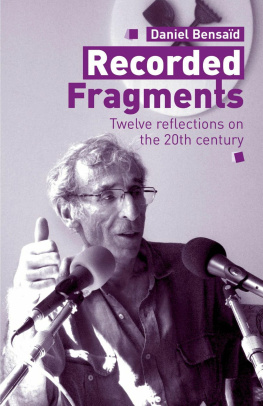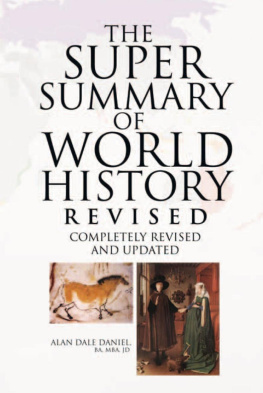BOOKS BY DANIEL J. BOORSTIN
The Creators
*
Hidden History
*
The Discoverers
*
The Americans: The Colonial Experience
The Americans: The National Experience
The Americans: The Democratic Experience
*
The Mysterious Science of the Law
The Lost World of Thomas Jefferson
The Genius of American Politics
America and the Image of Europe
The Image: A Guide to Pseudo-Events in America
The Decline of Radicalism
The Sociology of the Absurd
Democracy and Its Discontents
The Republic of Technology
The Exploring Spirit
*
For young readers:
The Landmark History of the American People
A History of the United States (with Brooks M. Kelley)
First Vintage Books Edition, September 1992
Copyright 1961 by Daniel J. Boorstin
Foreword to the 25th Anniversary Edition
copyright 1987 by Daniel J. Boorstin
Afterword copyright 2012 by Douglas Rushkoff
All rights reserved under International and Pan-American Copyright Conventions. Published in the United States by Vintage Books, a division of Random House, Inc., New York, and distributed in Canada by Random House of Canada Limited, Toronto. Originally published under the title The Image or What Happened to the American Dream . This edition first published by Atheneum, an imprint of Macmillan Publishing Company, New York, in 1987. Reprinted by arrangement with Atheneum Publishers, an imprint of Macmillan Publishing Company.
The author thanks the following for permission to use various quotations:
Michael Flanders and Donald Swann for four lines from Song of Reproduction; Grove Press, Inc. for a passage from The Stars , by Edgar Morin, translated by Richard Howard; Harcourt, Brace & World for a quotation from Senator Joe McCarthy , by Richard Rovere; Houghton Mifflin Company for a selection from The Fourth Branch of Government , by Douglass Cater; Alfred A. Knopf, Inc. for passages from Struggles and Triumphs , by P.T. Barnum, copyright 1927 by Alfred A. Knopf, Inc.; Paul S. Nathan for passages from his feature Rights and Permissions in Publishers Weekly; Saturday Review for quotations from Why Write It When You Cant Sell It to the Pictures, by Budd Schulberg, and Music to Hear, but Not to Listen To, by Stanley Green.
Library of Congress Cataloging-in-Publication Data
Boorstin, Daniel J. (Daniel Joseph).
The image: a guide to pseudo-events in America/Daniel J.
Boorstin.1st Vintage Books ed.
p. cm.
Originally published: 25th anniversary ed. New York: Atheneum, 1987.
eISBN: 978-0-307-81916-1
1. National characteristics, American. 2. United States
Civilization1945 3. United StatesPopular Culture
History20th century. I. Title.
E169.12.B66 1992
973.9dc2092-50080
v3.1
TO
THE UNIVERSITY OF CHICAGO
a place of light, of liberty, and of learning
My money affairs are in a bad way. You remember before the wedding, Anisim brought me some new rubles and half rubles? I hid one packet, the rest I mixed with my own. But now I cant make out which is real money and which is counterfeit, it seems to me they are all false coins. When I take a ticket at the station, I hand three rubles, then I think to myself: Are they false? And Im frightened. I cant be well.
ANTON CHEKHOV , The Hollow
Foreword to the 25th Anniversary Edition
W HEN THIS BOOK first appeared a quarter-century ago, television still had the charm of novelty and public relations was only in process of becoming one of the most powerful forces in American life. The Image was not yet a clich. This book was my own exploration of the momentous changes in the American view of reality. For the present edition I have left in the examples I used then, so that the reader, in sharing my own sense of discovery at that time, may also sense that present fashions have their roots in history. The reader can have the added pleasure of finding new examples every day.
This book has had a surprising vogue. It was not a best seller when it appeared, but it continues to live, to be quoted and to be assigned in colleges. It has been translated into the principal Western European languages and is in its thirtieth printing in Japanese.
Perhaps it is not surprising that it has had an even wider and more enthusiastic audience outside the United States than here at home. For we Americans are sensitive to any suggestion that progress may have its price. When the book appeared in 1962, I happened to be out of the country on a lecture engagement. Time , in reviewing The Image , said it was no wonder that the author left the country just before his slander on the United States was published.
Others have not been so hypersensitive about the facts of our life. Many have welcomed the vocabulary offered in this book for the new rhetoric of democracy. Pseudo-event, the expression I introduced here, has entered our dictionaries (and the Oxford English Dictionary), along with well-knownness, and these have entered the Western European vernacular. The definition of a celebrity as a person who is known for his well-knownness has almost become a familiar quotation.
Meanwhile our technology has reinforced the tendencies described in this book. Is there any advancefrom VHS and Cable TV to their unimaginable successorsthat has not multiplied and vivified pseudo-events? Is there any advance in transportationfrom the Walkman and the cellular telephone to supersonic planes and their successorsthat has not erased the differences between transportation and communication? Every day seeing there and hearing there takes the place of being there.
Still, the author never really knows what his book means. Especially today the authors view of what he has done, like everybody elses, is clouded by the blurring together of images and realities, the disorder that eyedoctors call diplopia. It is a fair testimony to this book that it has continued to puzzle, pique, and amuse quite a few. But my Foreword to this 25th anniversary edition, insisting on the books well-knownness, is only another evidence of how hard it is for any of us to escape the passion for pseudo-events that has accelerated, and still accelerates into the foreseeable future.
D ANIEL J. B OORSTIN June, 1987
Foreword to the First Edition
T HIS IS a how-not-to-do-it book. It is about our arts of self-deception, how we hide reality from ourselves. One need not be a doctor to know he is sick, nor a shoemaker to feel the shoe pinch. I do not know what reality really is. But somehow I do know an illusion when I see one.
This is a large subject for a small book. Yet it is too large for a big book. If I pretended in this volume to survey or comprehend all the bewitching unrealities of American life in the twentieth century, I would misrepresent the vastness of the subject. The task of disenchantment is finally not the writers but the readers. The complete survey must be made intimately by each American and for himself.
This book arises out of some very personal convictions. First, an affection for America and an amazement at America: acquired over the half century of my life, increased by periods of living abroad, and deepened by having spent my adult life studying the American past. Having read a good deal about the villains who are said to be responsible for our perplexitythe hidden persuaders, the organization men, Madison Avenue, Washington bureaucracy, the eggheads, the anti-intellectuals, the power lite, etc., etc., etc.I am unimpressed by their villainy. But I remain impressed by the perplexity of life in twentieth-century America. I have long suspected that our problems arise less from our weaknesses than from our strengths. From our literacy and wealth and optimism and progress.
Yet it is a mistake to believe that a wholesale problem can find a wholesale solution. From the beginning, the great promise of America was to open doors, so that men could try to work out their problems for themselvesnot necessarily alone, but in communities of their choosing, and toward often-uncertain ends which appealed to them.
Next page
